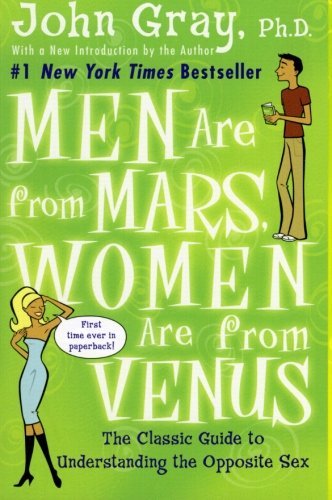In the vast realm of relationship literature, few titles have garnered the attention and intrigue of readers quite like “Men Are from Mars, Women Are from Venus” by John Gray. Published in the mid-1990s, this book swiftly ascended to the status of a cultural touchstone, shaping discussions around gender dynamics and interpersonal connection. Gray’s work confronts a commonplace observation: the seemingly insurmountable differences between the sexes. Yet, beneath this surface-level observation lies a tapestry woven with deeper psychological insights, historical context, and societal implications that merit extensive exploration.
The Fundamental Premise: Different Worlds
At its core, Gray posits a provocative notion: men and women exist in metaphorically separate worlds, each influenced by distinct emotional landscapes, communication styles, and behavioral patterns. He likens men to Martians and women to Venusians, a stark analogy that serves as the foundation for a conversation about the intrinsic differences between the genders. It’s an illustrative metaphor that not only captivates the imagination but also underscores the often bewildering interactions that characterize heterosexual relationships.
This dichotomy is crucial for understanding the frustrations many couples face. For instance, when men retreat into silence during conflict, they are often not dismissing their partners but rather engaging in a ‘cave’ mentality to process their emotions. Conversely, women may seek emotional connection through dialogue, perceiving silence as withdrawal or indifference. This misalignment is a frequent source of misunderstanding, rancor, and emotional distance. Gray explores these nuances, shedding light on why couples frequently find themselves in seemingly perpetual stand-offs, despite their love and commitment to one another.
Gender Conditioning: An Unseen Architect
The book delves deeper, probing the influences of gender conditioning—social constructs that dictate behaviors deemed appropriate for men and women. From an early age, girls are often encouraged to express their feelings and seek personal validation through relational connection, while boys are often socialized to project strength through independence and stoicism. Such conditioning creates a framework within which emotional interaction occurs, undeniably shaping the dynamics of adult relationships. Gray’s analysis invites readers to consider how these ingrained patterns contribute to misunderstandings that hamper intimacy.
The discourse on gender conditioning is vital, as it encourages a reflective approach. Understanding these social constructs enables individuals to foster empathy and compassion, recognizing that partners bring their own histories and lessons into a relationship. One might argue that this perspective is essential for dismantling harmful stereotypes and fostering mutual respect, thereby reinforcing the book’s enduring relevance.
Communication: The Bridge to Connection
One of Gray’s most compelling arguments centers on communication—an often cited, yet profoundly essential, aspect of romantic relationships. By framing gender-specific communication styles, the text unveils a complex interplay of expectations. Men typically employ a more succinct, action-oriented communication style, which can be perceived by women as brusque or emotionally detached. Women, in contrast, often favor a more elaborate, emotionally charged communication style, which men may interpret as overly intricate or confusing.
Yet, the challenge lies deeper than mere preference. Gray argues for a conscious effort to bridge these gaps. For example, he suggests that men cultivate the patience to listen to their partner’s needs without immediately seeking solutions, while women might consider simplifying their emotive expressions to facilitate better understanding. Such adaptations, while seemingly simple, require a significant shift in behavioral patterns that many struggle to implement.
The Role of Empathy and Understanding
As the narrative unfolds, empathy emerges as an indispensable tool for navigating the treacherous waters of romantic relationships. Gray emphasizes the importance of seeing beyond one’s own experiences and recognizing the emotional realities faced by one’s partner. When both individuals endeavor to incorporate empathetic understanding into their interactions, the likelihood of conflict diminishes significantly. By appreciating the disparate emotional needs and responses of their partners, couples can foster a more harmonious and fulfilling relationship.
This emphasis on empathy serves as a call to action: to cultivate a deeper connection that transcends surface-level differences. While it may seem daunting, the intrinsic rewards—improved communication, emotional intimacy, and mutual respect—are worth the effort. This cultivation of understanding creates not just a temporary fix to discord but also offers a foundational, ongoing framework for nurturing a healthy, loving relationship.
Critiques and Contemporary Relevance
Nonetheless, the book’s fundamental insights into communication and empathy remain pertinent in an increasingly complex social environment. In an era that champions diversity and inclusivity, adapting Gray’s principles to recognize the fluidity of gender roles can provide a contemporary lens through which to examine relationships. The underlying message—that love requires effort, understanding, and flexibility—remains a timeless truth.
Conclusion: A Call for Continued Exploration
